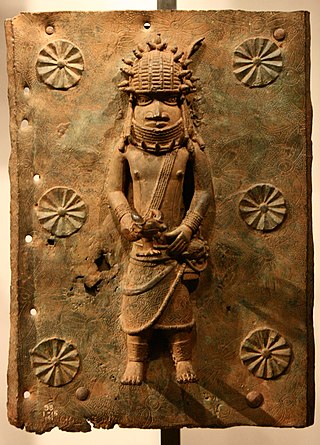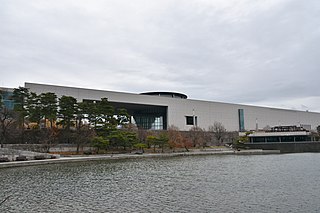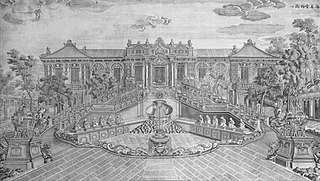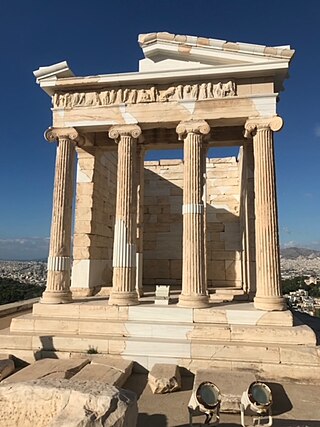
The Native American Graves Protection and Repatriation Act (NAGPRA), Pub. L. 101-601, 25 U.S.C. 3001 et seq., 104 Stat. 3048, is a United States federal law enacted on November 16, 1990.

The Iraq Museum is the national museum of Iraq, located in Baghdad. It is sometimes informally called the National Museum of Iraq, a recent phenomenon influenced by other nations' naming of their national museums; The Iraq Museum's name is inspired by the name of the British Museum, however. The Iraq Museum contains precious relics from the Mesopotamian, Abbasid and Persian civilizations. It was looted during and after the 2003 Invasion of Iraq. Despite international efforts, only some of the stolen artifacts have been returned. After being closed for many years while being refurbished, and rarely open for public viewing, the museum was officially reopened in February 2015.

The Palace Museum is a large national museum complex housed in the Forbidden City at the core of Beijing, China. With 720,000 square metres, the museum inherited the imperial royal palaces from the Ming and Qing dynasties of China and opened to the public in 1925 after the last Emperor of China was evicted.

Art theft, sometimes called artnapping, is the stealing of paintings, sculptures, or other forms of visual art from galleries, museums or other public and private locations. Stolen art is often resold or used by criminals as collateral to secure loans. Only a small percentage of stolen art is recovered—an estimated 10%. Many nations operate police squads to investigate art theft and illegal trade in stolen art and antiquities.

The Benin Bronzes are a group of several thousand metal plaques and sculptures that decorated the royal palace of the Kingdom of Benin, in what is now Edo State, Nigeria. Collectively, the objects form the best examples of Benin art and were created from the fourteenth century by artists of the Edo people. The plaques, which in the Edo language are called Ama, depict scenes or represent themes in the history of the kingdom. Apart from the plaques, other sculptures in brass or bronze include portrait heads, jewelry, and smaller pieces.
Archaeological ethics refers to the moral issues raised through the study of the material past. It is a branch of the philosophy of archaeology. This article will touch on human remains, the preservation and laws protecting remains and cultural items, issues around the globe, as well as preservation and ethnoarchaeology.

Repatriation is the return of the cultural property, often referring to ancient or looted art, to their country of origin or former owners.

Archaeological looting in Iraq took place since at least the late 19th century. The chaos following war provided the opportunity to pillage everything that was not nailed down. There were also attempts to protect the sites such as the period between April 9, 2003, when the staff vacated the Iraq Museum and April 15, 2003, when US forces arrived in sufficient numbers to "restore some semblance of order." Some 15,000 cultural artifacts disappeared in that time. Over the years approximately 14,800 were recovered from within and outside Iraq and taken under the protection of the Iraqi government.

The National Museum of Korea (Korean: 국립중앙박물관) is the flagship museum of Korean history and art in South Korea. Since its establishment in 1945, the museum has been committed to various studies and research activities in the fields of archaeology, history, and art, continuously developing a variety of exhibitions and education programs.

Looted art has been a consequence of looting during war, natural disaster and riot for centuries. Looting of art, archaeology and other cultural property may be an opportunistic criminal act or may be a more organized case of unlawful or unethical pillage by the victor of a conflict. The term "looted art" reflects bias, and whether particular art has been taken legally or illegally is often the subject of conflicting laws and subjective interpretations of governments and people; use of the term "looted art" in reference to a particular art object implies that the art was taken illegally.

The National Museum of Indonesia is an archeological, historical, ethnological, and geographical museum located in Jalan Medan Merdeka Barat, Central Jakarta, right on the west side of Merdeka Square. Popularly known as the Elephant Museum after the elephant statue in its forecourt, its broad collections cover all of Indonesia's territory and almost all of its history. The museum has endeavoured to preserve Indonesia's heritage for two centuries.

The Twelve Old Summer Palace bronze heads are a collection of bronze fountainheads in the shape of the Chinese zodiac animals that were part of a water clock fountain in front of the Haiyantang building of the Xiyang Lou area of the Old Summer Palace in Beijing. Believed to have been designed by the Jesuit Giuseppe Castiglione for the Qianlong Emperor, the statues would spout out water from their mouths to tell the time.
The antiquities trade is the exchange of antiquities and archaeological artifacts from around the world. This trade may be illicit or completely legal. The legal antiquities trade abides by national regulations, allowing for extraction of artifacts for scientific study whilst maintaining archaeological and anthropological context. The illicit antiquities trade involves non-scientific extraction that ignores the archaeological and anthropological context from the artifacts.

In February 2009, two bronze sculptures taken from the Old Summer Palace during the Second Opium War in 1860 were auctioned by international auction house Christie's. On 25 Feb 2009 the disputed 18th-century fountainheads — heads of a Rat and a Rabbit — were sold to Cai Mingchao (蔡銘超) for 28 million euros as part of an auction of art works owned by the late French designer Yves Saint Laurent. Cai is an adviser to the PRC's National Treasures Fund, which seeks to retrieve looted treasures by foreign invaders during the Qing dynasty. He then refused to pay the sum bid, claiming that he was bidding on moral and patriotic grounds.

The Carabinieri Command for the Protection of Cultural Heritage, better known as the Carabinieri T.P.C., is the branch of the Italian Carabinieri responsible for combatting art and antiquities crimes and is viewed as an experienced and efficient task force.

The Flying Horse of Gansu, also known as the Bronze Running Horse (銅奔馬) or the Galloping Horse Treading on a Flying Swallow (馬踏飛燕), is a Chinese bronze sculpture from circa the 2nd century CE. Discovered in 1969 near the city of Wuwei, in the province of Gansu, it is now in the Gansu Provincial Museum. "Perfectly balanced," says one authority, "on the one hoof which rests without pressure on a flying swallow, it is a remarkable example of three-dimensional form and of animal portraiture with the head vividly expressing mettlesome vigor."

The conservation and restoration of archaeological sites is the collaborative effort between archaeologists, conservators, and visitors to preserve an archaeological site, and if deemed appropriate, to restore it to its previous state. Considerations about aesthetic, historic, scientific, religious, symbolic, educational, economic, and ecological values all need to be assessed prior to deciding the methods of conservation or needs for restoration. The process of archaeology is essentially destructive, as excavation permanently changes the nature and context of the site and the associated information. Therefore, archaeologists and conservators have an ethical responsibility to care for and conserve the sites they put at risk.

Alberto Bonisoli is an Italian politician.
Douglas Arthur Joseph Latchford, "Dynamite" Doug Latchford, was a British art dealer and smuggler.
Nancy Wiener is an antiquities dealer who pleaded guilty to charges of conspiracy and possession of stolen property















